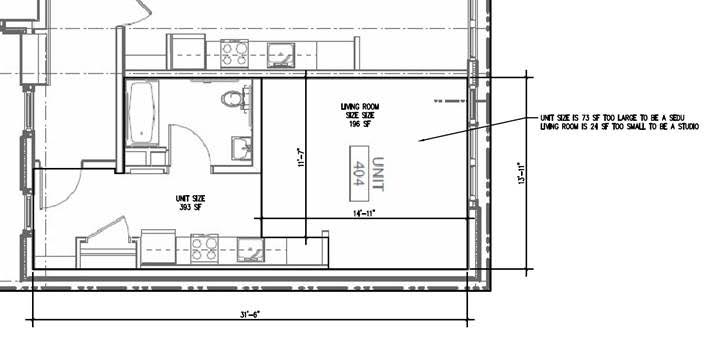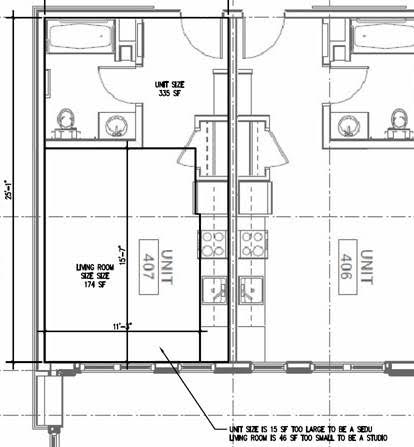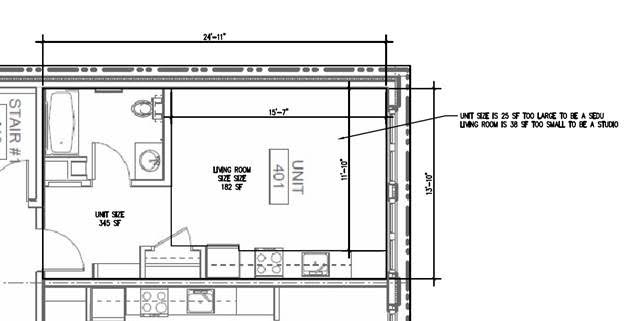The Black Hole: David Neiman on the Latest Changes to SEDUs
I know everyone is obsessing with James Comey right now, but here’s something that actually matters: what’s happening to smaller and more efficient apartments in Seattle because of regulation. Noted architect and Small Efficient Dwelling Unit (SEDU) advocate and expert has been warning the City about what their new rules are likely to do to SEDUS. The short answer is incentivize them to get bigger and more expensive for no real or good reason. The story is told in some correspondence between Neiman and the Director of Seattle’s Department of Construction and Inspections (SDCI). I think this will be far more interesting to you than James Comey.
[May 13, 2007]
Nathan,
As you know, I have expressed concerns about Seattle’s microhousing policy and how SDCI’s recent adoption of the 70-7 rule for determining habitable area artificially inflates minimum unit sizes, making our housing larger, less affordable, and less plentiful. This draft re-write of the directors rule for SEDUs DR 9-2017 is a small improvement over the previous version, but fails to provide the flexibility needed for architects to design SEDU’s of the size intended by the land use code (as small as 220sf). This policy issue aside, there is a larger, more fundamental code interpretation problem with this director’s rule that needs to be addressed before issuing a final version.
While DR 9-2017 offers SEDU’s a little flexibility with regard to the 70-7 rule, there is no such flexibility given to other unit types. SEDU’s have a maximum size of 320sf, but under the 70-7 rule many studio apartments will be challenged to achieve a 220sf living room in less than 360-370sf. Combination of the 70-7 rule and DR 9-2017 creates a situation where many studios between the size of 320-370sf are simply not legal – too small to be a studio and too large to be a SEDU. This is an absurd outcome, where SDCI’s interpretation of a code section intended to protect the public from (supposed) ill effects of living in too-small housing leads to an outcome where a larger unit is illegal but a smaller unit is allowed.
This is not a trivial flaw. For a real life example, see the plans for Plymouth Housing’s recently opened Sylvia Odom’s Place<http://web6.seattle.gov/
This isn’t a hard problem to fix, but it will require that SDCI and CCAB grapple with the fact that the 70-7 rule is overly conservative, inconsistent with what has been allowed in the past, and damaging to the city’s affordability goals and the HALA agenda.
To fix the problem, we need to expand the exception to the 70-7 rule created for SEDU’s in DR 9-2017 so that it applies to the measurement of habitable area in general, not just the habitable area within SEDU’s. DR 9-2017 allows 20% of the required living room area to be smaller than 7′ wide. If this 20% allowance was expanded to be a general rule, applicable to all minimum room areas in all unit types (not just SEDU’s), this would create a reasonable allowance for nooks & crannies that are typical in all unit types while still maintaining a requirement for a larger contiguous room consistent with SDCI’s goals. For example:
Unit Type Living Rm Area req’d Area >7′ req’d Area < 7′ allowed
SEDU 150sf 120sf 30sf
Studio 220sf 176sf 44sf
1 Bedroom 120sf 96sf 24sf
The solution above would be consistent with the CCAB’s rationale in creating DR 9-2017 while addressing its most egregious flaw. I implore you to give this matter the attention it deserves.
Regards,
David Neiman
Principal, Neiman Taber Architects, PLLC
[June 6, 2017]
Hi David—sorry for the delay in response. A lot is happening at SDCI.
Before I respond in full, I don’t exactly understand your issue with studios, specifically Sylvia Odom’s Place. Are you trying to qualify all studios as SEDU’s in order to take advantage of the different thresholds for SEPA and design review and in limited areas the parking requirement?
Nathan Torgelson
Director
[June, 6, 2017]
Nathan,
I can appreciate this may not be a top-of-the-agenda item, so thanks for getting back to me.
To answer your question: No, I am not trying to qualify all studios as SEDUs to avoid a land use process threshold. I am trying to resolve a problem in the way SDCI is interpreting and measuring minimum room sizes in dwelling units that creates a class of units between 320-370sf (or larger in some instances) that are simply illegal. To help explain, I have attached a pdf that shows a plan of Slyvia Odom’s place, along with some calculations of the unit size and the living room size for some of the typical units. Blow-ups details of those areas are pasted into the email below. This is a problem that we are running up against in all of our new projects that contain studio apartments.
The unit sizes shown are all larger than the 320sf maximum allowable size for a Small Efficiency Dwelling Unit (SEDU), so they would be classified as an Efficiency Dwelling Unit (EDU). An efficiency dwelling unit (also known as a studio) requires a minimum 220sf living room. Because of the way the new 70-7 rule excludes all room areas less than 7’ dimension from the living room area count, the living rooms of these studios are too small be considered a legal dwelling unit.
These units fall into the “black hole” I have described – too large to be a SEDU and too small to be a studio. We have projects that are running up against this problem & I have no way to proceed with the design of the project on a rational basis. Should I assume that SDCI is going to enforce the code this way & create a unit size between 320-370sf that is simply illegal? Or should I assume that SDCI will apply the dimensional flexibility for SEDUs outlined in DR 9-2017 to other unit types?
Projects like the Sylvia Odom [see below] could be “fixed” by widening the corridors to pull space out of the units to reclassify them as SEDUS. This would have the ironic effect of forcing applicants to reduce the size of their unit living rooms, an odd outcome given that the whole issue is driven by SDCI’s code interpretation aimed at ensuring that unit sizes do not become too small. Alternatively, the problem could be solved by reducing the unit count in order to make the units larger, resulting in housing that is more expensive and less plentiful, contrary to the city’s HALA agenda.
Does this explanation help?
-DEN




